
Erotic art is a broad field of the visual arts that includes any artistic work intended to evoke arousal. It usually depicts human nudity or sexual activity, and has included works in various visual mediums, including drawings, engravings, films, paintings, photographs, and sculptures. Some of the earliest known works of art include erotic themes, which have recurred with varying prominence in different societies throughout history. However, it has also been widely considered taboo, with either social norms or laws restricting its creation, distribution, and possession. This is particularly the case when it is deemed pornographic, immoral, or obscene.
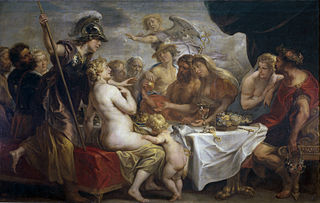
A figure painting is a work of fine art in any of the painting media with the primary subject being the human figure, whether clothed or nude. Figure painting may also refer to the activity of creating such a work. The human figure has been one of the constant subjects of art since the first Stone Age cave paintings, and has been reinterpreted in various styles throughout history.

Relief is a sculptural method in which the sculpted pieces remain attached to a solid background of the same material. The term relief is from the Latin verb relevare, to raise. To create a sculpture in relief is to give the impression that the sculpted material has been raised above the background plane. When a relief is carved into a flat surface of stone or wood, the field is actually lowered, leaving the unsculpted areas seeming higher. The approach requires a lot of chiselling away of the background, which takes a long time. On the other hand, a relief saves forming the rear of a subject, and is less fragile and more securely fixed than a sculpture in the round, especially one of a standing figure where the ankles are a potential weak point, particularly in stone. In other materials such as metal, clay, plaster stucco, ceramics or papier-mâché the form can be simply added to or raised up from the background. Monumental bronze reliefs are made by casting.
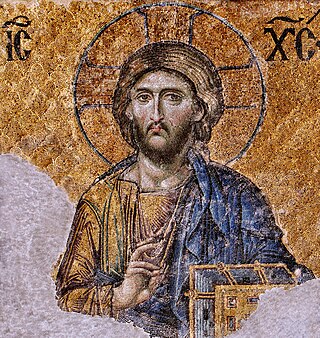
Byzantine art comprises the body of artistic products of the Eastern Roman Empire, as well as the nations and states that inherited culturally from the empire. Though the empire itself emerged from the decline of western Rome and lasted until the Fall of Constantinople in 1453, the start date of the Byzantine period is rather clearer in art history than in political history, if still imprecise. Many Eastern Orthodox states in Eastern Europe, as well as to some degree the Islamic states of the eastern Mediterranean, preserved many aspects of the empire's culture and art for centuries afterward.

William Rush was a U.S. neoclassical sculptor from Philadelphia, Pennsylvania. He is considered the first major American sculptor.
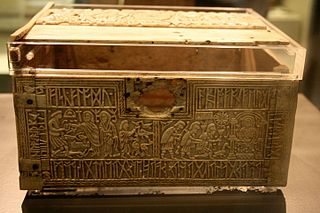
The Franks Casket is a small Anglo-Saxon whale's bone chest from the early 8th century, now in the British Museum. The casket is densely decorated with knife-cut narrative scenes in flat two-dimensional low-relief and with inscriptions mostly in Anglo-Saxon runes. Generally thought to be of Northumbrian origin, it is of unique importance for the insight it gives into early Anglo-Saxon art and culture. Both identifying the images and interpreting the runic inscriptions has generated a considerable amount of scholarship.

Ivory carving is the carving of ivory, that is to say animal tooth or tusk, generally by using sharp cutting tools, either mechanically or manually. Objects carved in ivory are often called "ivories".
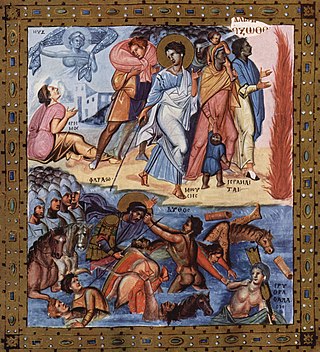
Macedonian art is the art of the Macedonian Renaissance in Byzantine art. The period followed the end of the Byzantine iconoclasm and lasted until the fall of the Macedonian dynasty, which ruled the Byzantine Empire from 867 to 1056, having originated in the theme of Macedonia. It coincided with the Ottonian Renaissance in Western Europe. In the 9th and 10th centuries, the Byzantine Empire's military situation improved, and art and architecture revived.
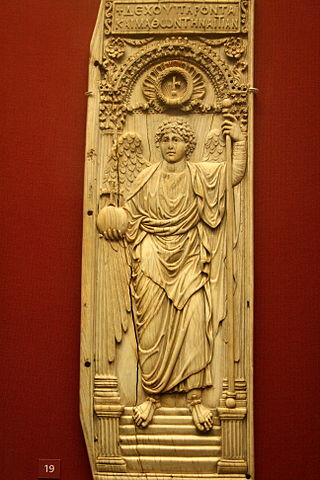
The Archangel ivory is the largest surviving Byzantine ivory panel, now in the British Museum in London. Dated to the early 6th century, it depicts an archangel holding a sceptre and imperial orb.

The object called by the museum Casket with Scenes of Romances is a French Gothic ivory casket made in Paris between 1330 and 1350, and now in the Walters Art Museum, Baltimore, Maryland. The casket is 4 5/8 inches high, 9 15/16 inches wide and 5 1/16 inches deep.

The Chest of Saint Simeon or Saint Simeon's Casket is a rectangular cedarwood sarcophagus in the shape of a chasse, overlaid with silver and silver-gilt plaques, said to hold the relics of St Simon the God-receiver; it is located over the main altar in the Church of Saint Simeon in Zadar, Croatia. The chest, considered a masterpiece of medieval art and also a unique monument of the goldsmith's craft of the age, is one of the most interesting works in gold in Europe now under the protection of UNESCO. It was made by local goldsmiths to an Italian design between 1377 and 1380.
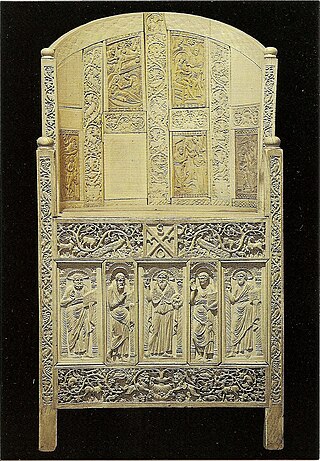
The Throne of Maximian is a cathedra that was made for Archbishop Maximianus of Ravenna and is now on display at the Archiepiscopal Museum, Ravenna. It is generally agreed that the throne was carved in the Greek East of the Byzantine Empire and shipped to Ravenna, but there has long been scholarly debate over whether it was made in Constantinople or Alexandria.

The Brescia Casket, also called the lipsanotheca of Brescia or reliquary of Brescia, is an ivory box, perhaps a reliquary, from the late 4th century, which is now in the Museo di Santa Giulia at San Salvatore in Brescia, Italy. It is a virtually unique survival of a complete Early Christian ivory box in generally good condition. The 36 subjects depicted on the box represent a wide range of the images found in the evolving Christian art of the period, and their identification has generated a great deal of art-historical discussion, though the high quality of the carving has never been in question. According to one scholar: "despite an abundance of resourceful and often astute exegesis, its date, use, provenance, and meaning remain among the most formidable and enduring enigmas in the study of early Christian art."

The Esquiline Treasure is an ancient Roman silver treasure that was found in 1793 on the Esquiline Hill in Rome. The hoard is considered an important example of late antique silver work from the 4th century AD, probably about 380 for the major pieces. Since 1866, 57 objects, representing the great majority of the treasure, have been in the British Museum.

The Uttoxeter Casket, also known as Philip Nelson's casket, is an Anglo Saxon reliquary from Uttoxeter, Staffordshire in the United Kingdom. As of 2017, it is held at the Cleveland Museum of Art in Ohio, United States. House-shaped and carved from a single piece of boxwood, it remains the only known surviving wood carving with such an elaborate iconographic programme from this period of British history.

The Troyes Casket is a carved ivory box of Byzantine origin. It is housed in the treasury of the Troyes Cathedral in Troyes, France.
The Salerno Ivories are a collection of Biblical ivory plaques from around the 11th or 12th century that contain elements of Early Christian, Byzantine, and Islamic art as well as influences from Western Romanesque and Anglo-Saxon art. Disputed in number, it is said there are between 38 and 70 plaques that comprise the collection. It is the largest unified set of ivory carvings preserved from the pre-Gothic Middle Ages, and depicts narrative scenes from both the Old and New Testaments. Some researchers believe the Ivories hold political significance and serve as commentary on the Investiture Controversy through their iconographies. The majority of the plaques are housed in the Diocesan Museum of the Cathedral of Salerno, which is where the group's main namesake comes from. It is supposed the ivories originated in either Salerno and Amalfi, which both contain identified ivory workshops, however neither has been definitively linked to the plaques so the city of origin remains unknown. Smaller groups of the plaques and fragments of panels are currently housed in different museum collections in Europe and America, including the Metropolitan Museum of Art in New York, the Louvre in Paris, the Museum of Fine Arts in Budapest, the Hamburg Museum of Art and Trade, and the Sculpture Collection in the Berlin State Museums.

The Morgan Casket is a medieval casket from Southern Italy, probably Norman Sicily. However, it reflects the Islamic style of the Fatimid Caliphate in Egypt, the culturally dominant power in the Western Mediterranean at the time. It is made from carved ivory and bone and is dated to the 11th–12th centuries AD.

The historical evolution of the nude in art runs parallel to the history of art in general, except for small particularities derived from the different acceptance of nudity by the various societies and cultures that have succeeded each other in the world over time. The nude is an artistic genre that consists of the representation in various artistic media of the naked human body. It is considered one of the academic classifications of works of art. Nudity in art has generally reflected the social standards for aesthetics and morality of the era in which the work was made. Many cultures tolerate nudity in art to a greater extent than nudity in real life, with different parameters for what is acceptable: for example, even in a museum where nude works are displayed, nudity of the visitor is generally not acceptable. As a genre, the nude is a complex subject to approach because of its many variants, both formal, aesthetic and iconographic, and some art historians consider it the most important subject in the history of Western art.

The Embriachi workshop was an important producer of objects in carved ivory and carved bone, set in a framework of inlaid wood, in north Italy from around 1375 to perhaps as late as 1433, apparently moving from Florence to Venice about 1395. They are especially known for what are now called marriage caskets or wedding caskets, hexagonal or oblong caskets about a foot across, with lids that rise up in the centre. Their output of these was probably made for stock rather than individual commissions, and filled a market for gifts for betrothals and weddings. They sold mirrors framed in a similar style, though fewer of these have survived, and religious pieces both small and in a few cases very large.























